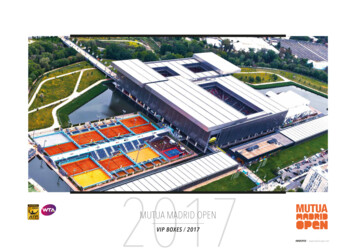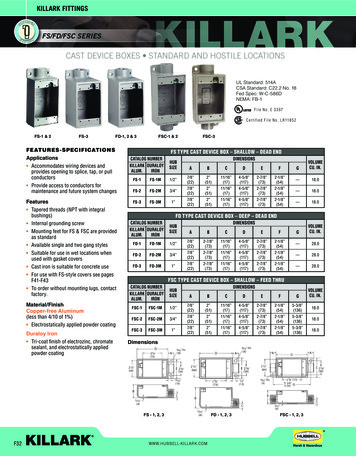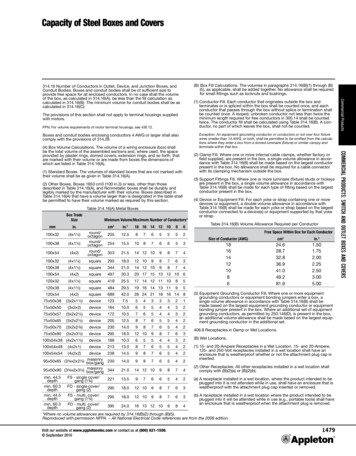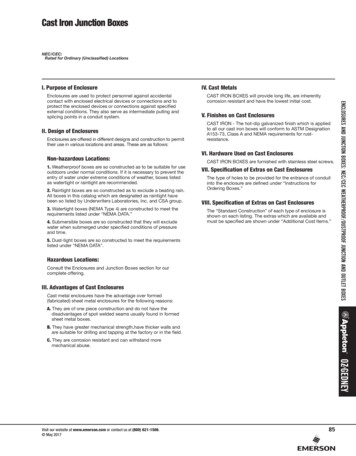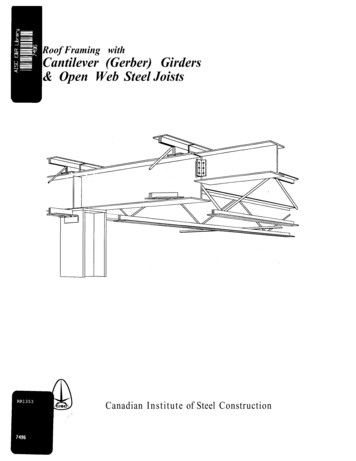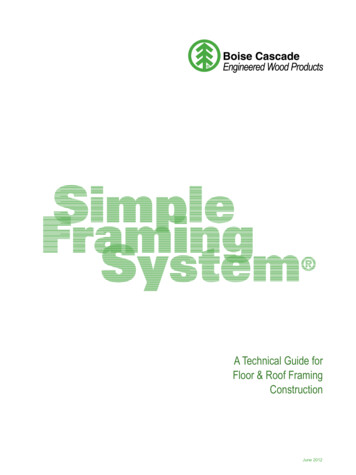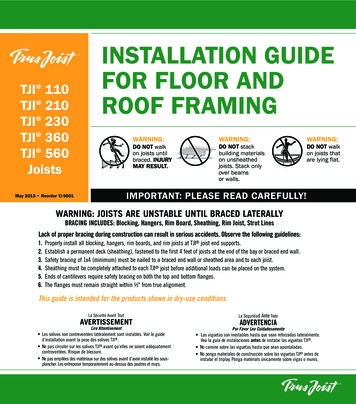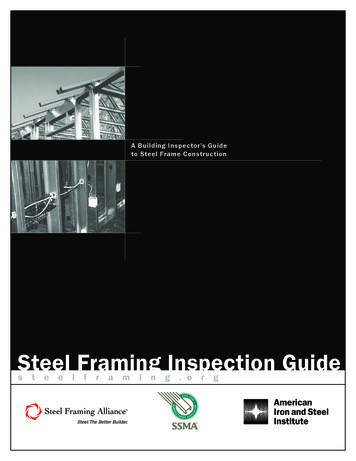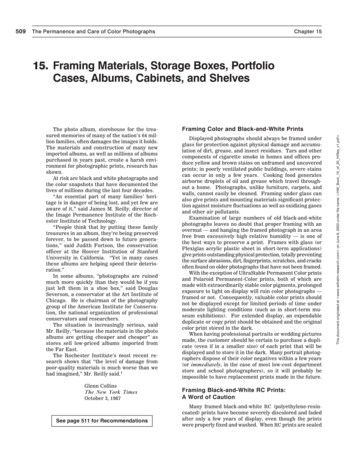
Transcription
The Permanence and Care of Color PhotographsChapter 1515. Framing Materials, Storage Boxes, PortfolioCases, Albums, Cabinets, and ShelvesThe photo album, storehouse for the treasured memories of many of the nation’s 64 million families, often damages the images it holds.The materials and construction of many newimported albums, as well as millions of albumspurchased in years past, create a harsh environment for photographic prints, research hasshown.At risk are black and white photographs andthe color snapshots that have documented thelives of millions during the last four decades.“An essential part of many families’ heritage is in danger of being lost, and yet few areaware of it,” said James M. Reilly, director ofthe Image Permanence Institute of the Rochester Institute of Technology.“People think that by putting these familytreasures in an album, they’re being preservedforever, to be passed down to future generations,” said Judith Fortson, the conservationofficer at the Hoover Institution of StanfordUniversity in California. “Yet in many casesthese albums are helping speed their deterioration.”In some albums, “photographs are ruinedmuch more quickly than they would be if youjust left them in a shoe box,” said DouglasSeverson, a conservator at the Art Institute ofChicago. He is chairman of the photographygroup of the American Institute for Conservation, the national organization of professionalconservators and researchers.The situation is increasingly serious, saidMr. Reilly, “because the materials in the photoalbums are getting cheaper and cheaper” asstores sell low-priced albums imported fromthe Far East.The Rochester Institute’s most recent research shows that “the level of damage frompoor-quality materials is much worse than wehad imagined,” Mr. Reilly said. 1Glenn CollinsThe New York TimesOctober 3, 1987See page 511 for RecommendationsFraming Color and Black-and-White PrintsDisplayed photographs should always be framed underglass for protection against physical damage and accumulation of dirt, grease, and insect residues. Tars and othercomponents of cigarette smoke in homes and offices produce yellow and brown stains on unframed and uncoveredprints; in poorly ventilated public buildings, severe stainscan occur in only a few years. Cooking food generatesairborne droplets of oil and grease which travel throughout a home. Photographs, unlike furniture, carpets, andwalls, cannot easily be cleaned. Framing under glass canalso give prints and mounting materials significant protection against moisture fluctuations as well as oxidizing gasesand other air pollutants.Examination of large numbers of old black-and-whitephotographs leaves no doubt that proper framing with anovermat — and hanging the framed photograph in an areafree from excessively high relative humidity — is one ofthe best ways to preserve a print. Frames with glass (orPlexiglas acrylic plastic sheet in short-term applications)give prints outstanding physical protection, totally preventingthe surface abrasions, dirt, fingerprints, scratches, and cracksoften found on older photographs that have not been framed.With the exception of UltraStable Permanent Color printsand Polaroid Permanent-Color prints, both of which aremade with extraordinarily stable color pigments, prolongedexposure to light on display will ruin color photographs —framed or not. Consequently, valuable color prints shouldnot be displayed except for limited periods of time undermoderate lighting conditions (such as in short-term museum exhibitions). For extended display, an expendableduplicate or copy print should be obtained and the originalcolor print stored in the dark.When having professional portraits or wedding picturesmade, the customer should be certain to purchase a duplicate (even if in a smaller size) of each print that will bedisplayed and to store it in the dark. Many portrait photographers dispose of their color negatives within a few years(or immediately , in the case of most low-cost departmentstore and school photographers), so it will probably beimpossible to have replacement prints made in the future.Framing Black-and-White RC Prints:A Word of CautionMany framed black-and-white RC (polyethylene-resincoated) prints have become severely discolored and fadedafter only a few years of display, even though the printswere properly fixed and washed. When RC prints are sealedThis document originated at www.wilhelm-research.com on June 6, 2003 under file name: HW Book 15 of 20 HiRes v1.pdf 509
Exhibition galleries at the Art Institute of Chicago. Frames provide photographs with a semi-sealed environment that offersexcellent protection against dirt, physical damage, and (to some extent) the effects of air pollutants. Carefully chosenframes also enhance the appearance of displayed photographs.in a frame, oxidants produced by the deteriorating effectsof light and UV radiation on the RC base can accumulateinside the frame and attack the silver image, causing eitherlocalized or overall yellow or orange-red discolorations.High-humidity conditions accentuate this type of imagedeterioration. There is also evidence that black-and-whiteRC papers are more susceptible than fiber-base papers toimage discoloration caused by other sources, such as atmospheric pollutants, surface contaminants, or reactivesubstances in framing and filing materials.The most important single factor that determines whether— or how soon — a displayed RC print will discolor is thetype of paper with which the print is made. This author hasseen countless prints from the 1970’s and early 1980’s madewith Kodak Polycontrast Rapid RC Paper, Kodak Polycontrast Rapid II RC Paper, and Ilford Ilfospeed Paper whichbecame severely discolored as a consequence of exposureto light on display. Most of these prints had been framed;however, some were simply tacked to a wall and were exposed to the open air. The Corcoran Gallery of Art inWashington, D.C., the Art Institute of Chicago, and theNational Archives of Canada in Ottawa, among other wellknown institutions, now have black-and-white RC prints intheir collections that became severely discolored after onlya few years of display and storage; with the passage oftime, it is inevitable that huge numbers of prints worldwideare going to be affected.Image deterioration of Polycontrast Rapid RC prints ischaracterized by extreme yellow and orange discolorationsand formation of silver mirror-like deposits along densitygradient lines (e.g., at the junction of white and black image areas). Some Polycontrast Rapid RC prints have alsodeveloped large numbers of small, circular orange-red discolorations (known as redox blemishes, or microspots);previously associated primarily with microfilms and astronomical plates, such defects have not, to this author’s knowledge been encountered in any fiber-base prints. SomePolycontrast Rapid RC prints have also suffered from crackingof the emulsion-side RC layer; many Ektacolor RC printsfrom the late 1960’s and early 1970’s also have sufferedfrom RC base cracking.Image deterioration of displayed Ilford Ilfospeed printsis generally characterized by an overall yellow-brown discoloration, which is quite different in appearance from thediscoloration seen with Kodak RC prints. Many Ilford RCprints from the late 1970’s and early 1980’s also suffer frompronounced brownish discoloration of the RC paper base;the discoloration, believed to be caused by developer chemicals incorporated into the paper’s emulsion during manufacture, is most obvious on the backside of the prints.This document originated at www.wilhelm-research.com on June 6, 2003 under file name: HW Book 15 of 20 HiRes v1.pdf 510Chapter 151982Framing Materials, Storage Boxes, Portfolio Cases, Albums, Cabinets, and Shelves
The Permanence and Care of Color PhotographsChapter 15RecommendationsFraming Materials Frames: Aluminum section frames are inert, inexpensive,lightweight, unaffected by moisture fluctuations, and otherwise ideally suited for framing photographs. Stainless steeland brass are also safe, but are expensive and heavy. Woodframes should not be used for black-and-white photographs,although they probably will not harm color prints. Museumsand archives should avoid wood frames altogether. Glazing: Glass and high-quality acrylic plastic sheet (e.g.,Plexiglas or Lucite) are recommended for color photographs.UV-absorbing grades of acrylic sheet offer little if any additional protection against light fading for most types of colorphotographs. Glass — although it is subject to breakage —is less expensive and has much greater resistance to scratchingthan plastic. Although Plexiglas and other plastics are satisfactory for framing in short-term exhibitions and travelingshows, they should be avoided for long-term use with blackand-white photographs. Prevent contact between prints and framing glass: Overmats are recommended to lessen the possibility of printssticking to framing glass or plastic over time. Frame moisture barriers: Aluminum foil or polyester (e.g.,DuPont Mylar or ICI Melinex) should be placed between themount board and backing board of framed prints, except forblack-and-white RC prints; for these, the author tentativelyrecommends that a vapor barrier be omitted to allow peroxides generated by the RC print base during prolonged exposure to light to gradually diffuse out of the frame. Framesshould not be “vented.” Backing boards: Aluminum sheet, high-quality mount board,corrugated polypropylene “cardboard,” and Lig-free Type IIbox board (Conservation Resources International) are recommended. Ordinary cardboard, chipboard, plywood, andMasonite should all be strictly avoided. Fome-Cor and otherpolystyrene-foam laminate boards are probably satisfactoryfor backing (and mounting) expendable color prints intendedfor display, but should be avoided for valuable black-andwhite prints.Storage Containers Cardboard storage boxes: Lig-free Type II boxes (Conservation Resources International) are recommended for general storage of prints and negatives. Ordinary cardboardboxes, including those in which photographic manufacturerspackage and sell their paper, should not be used for otherthan temporary storage. Wood boxes should be strictly avoided. Portfolio cases and clamshell boxes: Because all currently available print storage boxes of this type are constructed with low-quality, lignin-containing (and usually acidic)binders board, none can be recommended for long-term storage of black-and-white photographs, although they probablyare safe enough for color prints. Several firms, includingPortfoliobox and Museum Box Company, can supply custommade boxes (at extra cost) in which 100% cotton fiber mountboard has been substituted for binders board; these boxesshould be satisfactory for long-term applications. Pyroxylinimpregnated cover fabrics should be avoided; acrylic-coatedfabrics are recommended. Solander boxes: These boxes are made with wood framesand binders board (usually covered with pyroxylin-coatedfabrics) and are not satisfactory for the long-term storage ofblack-and-white photographs, especially photographs madeby some of the historical processes, such as albumen prints.The boxes are probably safe for color prints. Also called“museum cases,” these boxes are sold by Spink and Gaborc,Light Impressions, University Products, and others; they arefound in most major museum collections. On special order,Spink and Gaborc can substitute 100% cotton fiber mountboard for binders board and replace the pyroxylin-coatedfabric with an acrylic-coated fabric; the wood frame is stillused, however. Should a Solander box be required, thissomewhat more expensive box is recommended. Extrudedaluminum or an inert plastic such as polypropylene could beused to replace the potentially harmful wood frames in Solander boxes; at the time this book went to press, however, suchan improved box was not commercially available.Photograph Albums Recommended: High-quality albums with paper pages andpolyester-covered pages are available from Light Impressions,University Products, and Photofile; often referred to as “archival” albums, these fairly high-priced albums appear to bequite satisfactory for museum and other long-term applications. Well-designed but much less expensive albums consisting of good-quality paper pages with Melinex polyestercovered “Picture-Pockets” are supplied by Webway Incorporated under the Webway Family Archival Album name. Theseexpandable albums, many of which have an ample writingarea below each print for captions, are available in sizes for31 2 x 5–inch and 4 x 6–inch prints. Webway Family Archivalalbums are the author’s primary recommendation for generalhome and amateur use for both color and black-and-whitephotographs. Probably also satisfactory are albums withpolypropylene-covered pages available from the Holson Company. Hallmark Cards supplies albums with cellulose acetatepages; these appear to be suitable for small amateur prints. Albums to be avoided: Albums with self-stick, plastic-covered “magnetic” pages can be extremely harmful and shouldnot be used. If, however, one insists on using a self-stickalbum, the FlashBacks brand photo albums supplied by the3M Company are recommended by this author as the safestalbum of this type. Also to be avoided are surface-treated,heat-sealed polypropylene pages (e.g., C-Line, 20th CenturyPlastics, and Light Impressions notebook pages); pages containing polyvinyl chloride [PVC] (e.g., 20th Century Plasticsnotebook pages); low-density polyethylene pages (e.g., PrintFile, Vue-All, and Clear File pages); and albums with pagesmade of low-grade paper, especially cheap black paper.Cabinets and Shelves Recommended construction materials: Steel or aluminumcoated with baked enamel, chrome- or nickel-plated steel,anodized aluminum, and stainless steel. (Baked-enamel-coatedsteel cabinets, shelves, filing cabinets, and blueprint files ofthe kind widely sold for office use ar
Light Impressions, University Products, and others; they are found in most major museum collections. On special order, Spink and Gaborc can substitute 100% cotton fiber mount board for binders board and replace the pyroxylin-coated fabric with an acrylic-coated fabric; the wood frame is still used, however. Should a Solander box be required, this
